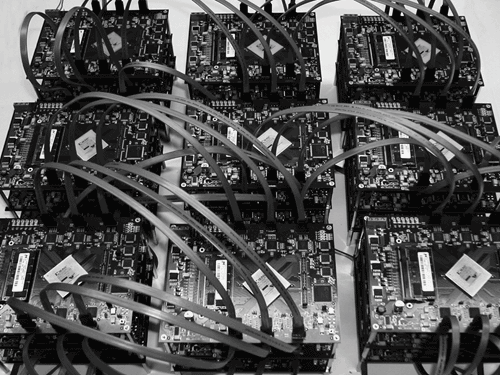Section B.1. Application Overview
B.1. Application OverviewA team at Montana State University led by Dr. Ross Snider has been funded by the National Science Foundation to develop a computational platform that will help further the understanding of how the nervous system encodes information. The system being developed, which is pictured in Figure B-1, includes an array of 27 Xilinx Virtex-II FPGAs connected via high-speed serial interfaces (with larger future scale-ups likely) that will be used to analyze and build a model of an insect brain. Figure B-1. An array of 27 Xilinx FPGAs connected via high-speed serial links (photo courtesy of Dr. Ross Snider, Montana State University).
Dr. Snider is collaborating with scientists at the Center for Computational Biology at MSU, where the aim is to connect this hardware directly to an insect (a cricket), analyze neural data in real time, and insert new models that will interact with the recorded data. To do so, the data needs to be processed in real time and the models run as fast as practical within the limits of the computational resources. Dr. Snider's team evaluated a conventional DSP approach, but the benchmarks indicated that DSPs would not provide the needed performance. An array of FPGAs, however, does provide the computational horsepower required at a relatively low cost. Benchmarks conducted using a single Virtex-II 3000 device indicate speed enhancements of up to 200 times are practical for certain neural simulations when compared to conventional processors. The create the system, performance-critical algorithms describing how the sodium or potassium channels work inside a neuron are developed as FPGA-resident processes. These processes are mapped onto the FPGA-based platform, creating a grid computing system for biological simulations. The end goal of the project is to create a platform, supported with high-level tools, that can be an enabling force in the discovery of how to decode neural information in real time. This research will eventually enable individuals to control prosthetic limbs just by thinking, in the same way healthy limbs are controlled by the brain. Xilinx has helped with this project by donating the necessary FPGA devices. The National Institutes of Health (NIH) has expressed interest in the project and is acting as a funding source. More about this project can be found at www.hylitech.com. |
EAN: 2147483647
Pages: 208
